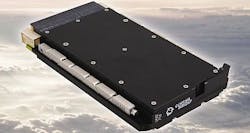3U OpenVPX graphics display card for aircraft and ground vehicles offered by Curtiss-Wright
ASHBURN, Va., 1 Jan. 2014.Curtiss-Wright Controls Defense Solutions in Ashburn, Va., is introducing the VPX3-716 3U OpenVPX six-head graphics display card for demanding graphics-rich applications in aircraft and ground vehicles that require extensive video processing and display capabilities.
The module is based on the AMD next-generation embedded Radeon Adelaar graphics processing unit (GPU), and meets the long-lifecycle availability required for military programs through use of a suite of CoreAVI software drivers supported with 20-year component supply program, company officials say.
The VPX3-716 is suited for embedded training, moving maps, geographic information systems (GIS), 360-degree situational awareness, diminished vision enhancement (DVE) and other graphics and video-intensive applications.
The rugged VPX3-716 3U OpenVPX module has six independent graphics outputs, 2 gigabytes of dedicated video memory, and H.264 MPEG4 motion video decoders.
The VPX3-716 is supported by CoreAVI's suite of embedded software drivers, including OpenGL graphics, OpenCL compute driver, and H.264/MPEG 2 video decode drivers.
The CoreAVI software drivers are designed to enable advanced graphics and video support on real-time and safety-critical operating systems including Wind River VxWorks, and on customer proprietary platforms.
For applications that require safety certification, CoreAVI's software suite includes FAA RTCA DO-178C and DO-254 certification packages that simplify and speed time to market and enable long term availability through the company's 20 year component supply programs.
For more information contact Curtiss-Wright Controls Defense Solutions online at www.cwcdefense.com.

